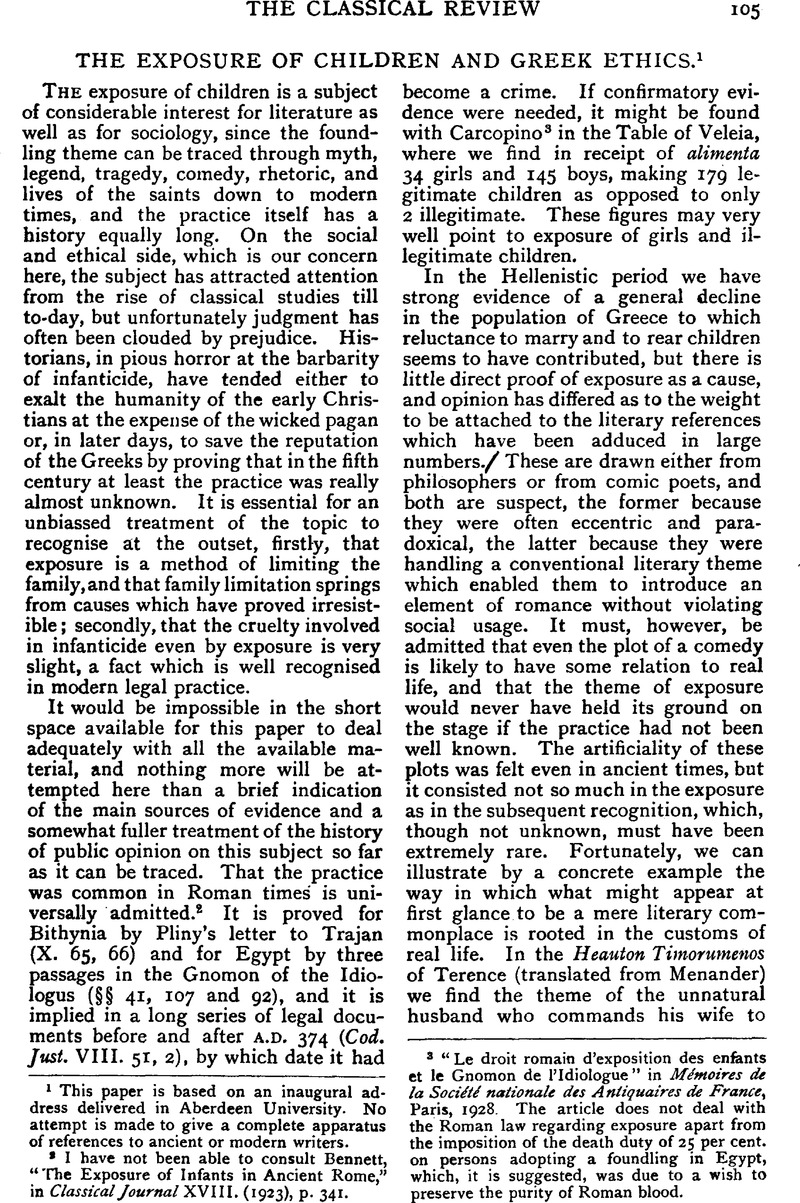Published online by Cambridge University Press: 27 October 2009

page 105 note 2 I have not been able to consult Bennett, , “The Exposure of Infants in Ancient Rome,” in Classical Journal XVIII. (1923), p. 341.Google Scholar
page 105 note 3 “Le droit romain d'exposition des enfants et le Gnomon de l'Idiologue” in Mémoires de la Société nationale des Anliquaires de France, Paris, 1928Google Scholar. The article does not deal with the Roman law regarding exposure apart from the imposition of the death duty of 25 per cent. on persons adopting a foundling in Egypt, which, it is suggested, was due to a wish to preserve the purity of Roman blood.
page 106 note 1 van Hook, La Rue, Trans. Am. Phil. Ass., 1920Google Scholar; Bolkestein, , Class. Phil. XVII. (1922).Google Scholar
page 107 note 1 Euripides, Ion 27.
page 107 note 2 I have not thought it worth while to discuss the interpretation of γχυτριειῖς in Wasps 289. The scholiast connects it with the practice of exposure ν χτρα, and I see no reason to doubt that the verb might have had its meaning extended to adults. The exact meaning of γχυτρστρια is more doubtful (v. Bolkestein).
page 107 note 3 It is known historically in Babylonia and is found in the tales of Moses and Sargon as well as in Greek mythology.
page 107 note 4 For this v. Arist. Hist. An. VII., 588a 8.
page 111 note 1 Ilberg, in Archiv für Religionswissenschaft XIII. (1910), p. 1Google Scholar, ‘Zur gynäkologischen Ethik der Griechen.’
page 111 note 2 Minucius Felix XXXI.; Tertullian, , ad Nationes I. 15Google Scholar; Ambrose, , de Nebuthe V. 21Google Scholar, Hexamer. V. 18; August. Ep. XCVIII.; Lactant, . Inst. Div. VI. 20Google Scholar; Justin, , Apol. I. 27Google Scholar; Epistula ad Diogn. 5; Athenagoras XXXIII.; Origen, , contra Celsum VIII. 55Google Scholar; Alex, Clem., Paedag. III. 3.Google Scholar
page 112 note 1 Hist. V. 5.
page 113 note 1 This same locus communis is used of the Picts (r γεννώμενα πντα κοινς κτρφοντες Dio Cass. LXXVI. 12) and of the Etruscans (τρφειν τοὺς Τυρρηνοὺς πντα τ γινμενα παιδα Theopompus in Athen. XII. 517d). Kornemann, , Die Stellung der Frau, etc. (p. 29 ff.) takes these passages seriously.Google Scholar